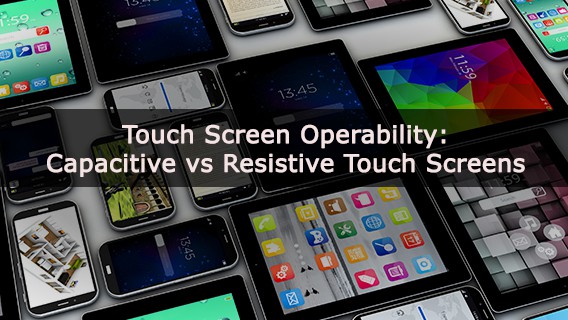From cell phones to factory floors, touch screens have become a ubiquitous part of computers in our daily lives. But for how much time we spend swiping, tapping, and scrolling, how much do we actually know about these pieces of technology?
There are two major types of touch screens: capacitive and resistive. Together, they provide the interface for countless consumer products and industrial devices. Today, we’ll break down the differences between the two designs and where they’re best suited for industrial applications.
Why Use Touch Screens in Industrial Applications
Article Guide
Touch screens are extremely popular in industrial roles for two primary reasons:
- They’re easy to use. Users can simply tap the icon or button on the screen for the function they want rather than having to type in commands.
- They don’t require accessories or peripheral devices. Because the display also serves as the control interface, computers with touch screens don’t need mice or keyboards. This helps save space, which can be critical in a cramped environment like a factory floor or oil rig.
Capacitive and Resistive Touch Screens and How They Work
The most significant difference between the two categories of touch screens lies in how they detect a user’s touch. This difference shapes how and where these screens can be used.
Capacitive Touch Screens
A capacitive touch screen works by sensing the electrical current in a human being’s body. Underneath the glass screen is an insulator and conductive layer that tracks changes in electrical charge. When the user touches the screen, it draws charge to the point of contact, which the system then interprets as input. Capacitive touch screens can even support multitouch operations, expanding their flexibility. This makes them the most common choice for touch screens in electronics such as industrial-grade tablets.
Resistive Touch Screens
These touch screens rely on physical pressure for detecting inputs. In a resistive design, two thin layers of plastic with a tiny gap in between are coated in an electrically conductive material. When a user presses down on the screen, these two layers make contact, which the touch screen’s computer then registers as an input.
The Advantages and Disadvantages of Capacitive vs. Resistive
Despite fulfilling similar roles, capacitive and resistive screens have distinct strengths and weaknesses that see them used in different areas of industry.
Capacitive
One of the greatest advantages of capacitive versus resistive touch screens is that a capacitive screen can support multitouch gestures. This allows for a far greater degree of flexibility when it comes to inputs and expands what a user can accomplish with their touch screen industrial computer. Additionally, the glass surface of a capacitive screen is easier to see through and less likely to scratch than a plastic screen.
Sadly, that glass screen is also more prone to cracking if dropped. The other disadvantage of capacitive screens is that they can be disrupted by water or dirt on the screen, causing false inputs. The screen’s reliance on an electric current also means that non-conductive objects, such as thick gloves or most styluses, won’t work with a capacitive screen.
Resistive
The main advantages of resistive touch screens are that they are cheap and reliable. Because they rely on pressure instead of electrical charge to detect inputs on the screen, a user can still perform changes with a stylus or while wearing gloves. They are also more durable than capacitive screens and less vulnerable to dirt, water, or dust.
The main disadvantage of resistive screens is that they are not very precise and can require more effort from users to perform inputs. They are also somewhat more susceptible to degradation over the years, which can be a problem if longevity is a priority.
Which Screen Should You Use?
The choice between capacitive and resistive will come down to the role the touch screen will be used in. Capacitive screens can support a greater variety of applications and are more precise, which makes them ideal for consumer applications (this is why consumer smartphones use capacitive touch screens). They are, however, more fragile and more expensive. This means they may not be the ideal solution where exposure to the elements or equipment damage is a concern.
On the other hand, resistive screens are cheaper and do better in outdoor applications, such as construction or areas where dirt and water are a concern. However, they are less accurate and less flexible. If you need something durable and relatively inexpensive, a resistive touch screen is the right choice for you.
Conclusion
Touch screens are incredibly useful for all kinds of industries. However, using them effectively requires understanding the strengths and weaknesses of both capacitive and resistive screens and what environments they’re best suited for.
If you’re interested in adding touch screen industrial-grade computers to your business’s operations, contact the team at Cybernet Manufacturing. Our expert staff are more than eager to explain how our products can expand your company’s capabilities.
Join the conversation and connect with us on this and other relevant topics – Follow us on Facebook, Twitter, and LinkedIn.
Touch Screen Operability: Capacitive vs Resistive Touch Screens
October 25, 2015
Many businesses today can benefit with an upgrade to PCs utilizing touch screen technology. With intuitive application, PCs and tablets equipped with touch screen capabilities allow for more streamlined operations, with…
0 Comments6 Minutes
You Can't
Learn from a Pop-up
But we can deliver knowledge to your inbox!
We dive deep in the industry looking for new trends, technology, news, and updates. We're happy to share them with you.
Knowledge, News, and Industry Updates Right in Your Inbox



